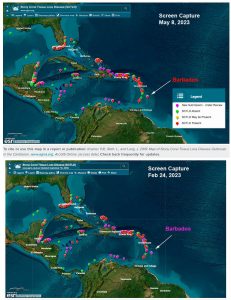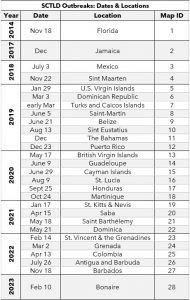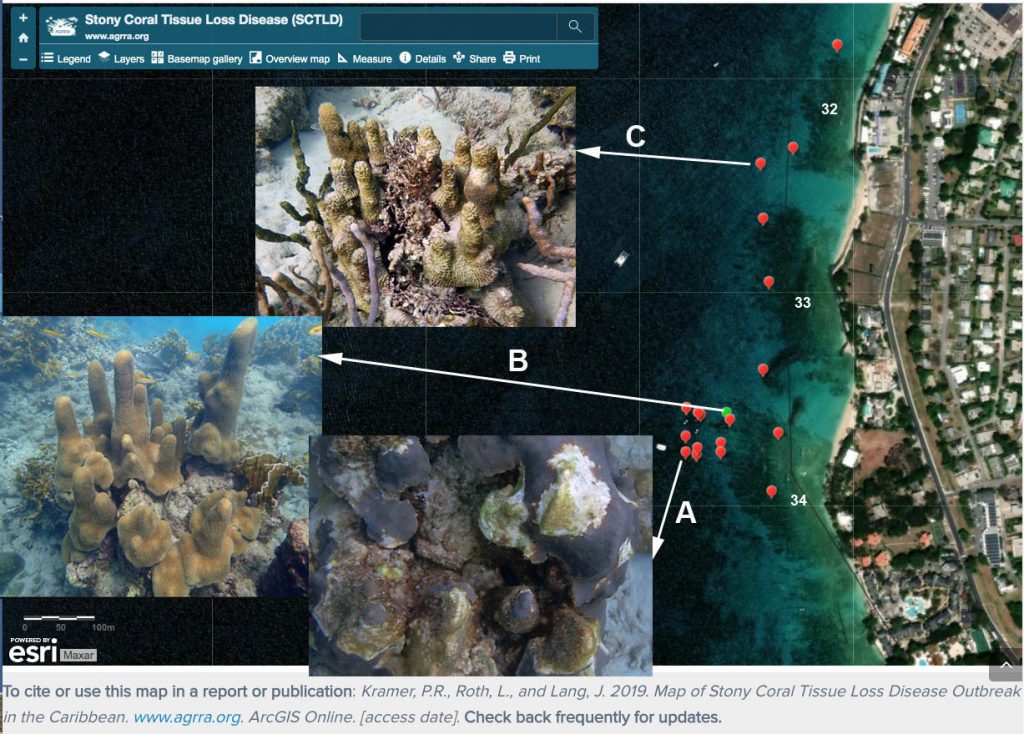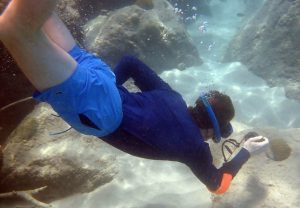
Screen Captures from AGRRA Interactive Map for the whole region. Below: on Feb 24 (Barbados purple). Above: on Nov 8 (Barbados red). Barbados lies east of and upstream from the other islands of the Lesser Antilles.
Click on images for larger version
UPDATE 30 May, 2023: McGill students release their final report: Occurrence of Stony Coral Tissue Loss Disease on Vauxhall Reef and a Breakwater in the Folkstone Marine Protected Area of Barbados (28.7 MB)
—————–
“Stony coral tissue loss disease (SCTLD) is a highly lethal coral disease that was first reported off the coast of Florida in 2014 and has since spread rapidly throughout the Caribbean. The disease affects over 20 coral species… The large geographic scale of this outbreak, high lethality of the disease lesion, and broad susceptibility among coral species make SCTLD unprecedented in its ecological impact, and likely make it the most deadly coral disease outbreak in history.” – Coral Disease Health Consortium (U.S, Government sponsored)
I have been on the lookout for this disease during annual visits to Barbados in the Jan to March interval since I first learned about it in 2019 (view post Jul 9, 2019). I missed visiting Barbados in 2021 and 2022, but I observed possible cases early on in January of 2023 (view post Jan 25, 2023). I submitted observations to the AGRRA Interactive Map/Database on SCTLD, 25 sets in total those mostly on sites in the Folkestone MPA (Marine Protected Area) on the west coast.
Up until the time I left (April 7, 2023), the Barbados tag on this map was still coloured purple, meaning all Barbados observations remained under review. The tag was still purple on April 28th. However, on May 8 the tag had flipped to red, meaning enough evidence had accumulated to confirm the presence of SCTLD in Barbados.
AGRRA
AGRRA refers to the Atlantic and Gulf Rapid Reef Assessment (AGRRA) Program:
We are an international collaboration of scientists, managers, and supporters aimed at improving the regional condition of reefs in the Western Atlantic and Gulf of Mexico…We curate and distribute data, research and educational materials that support this mission.
AGRRA’s Interactive Map/database for SCTLD shows the geographical distribution of Reports to AGRRA of possible and confirmed occurrences of SCTLD and shares the photos and some of the site info in those reports. Photos 0f a coral (or a set of corals at one location) that are suspected to be infected with SCTLD are submitted online to AGRRA along with site info (depth, reef zone, etc). The locations are immediately posted on the Interactive Map map and tagged purple (“Under Review”). Postings to the Interactive Map are periodically reviewed by AGGRA and tags changed to green (“SCTLD absent”), yellow (“SCTLD may be present”) or red (“SCTLD present”), or remain purple as the evidence to date indicates.
Spread of SCTLD though the Caribbean

SCTLD Outbreaks: Dates & Locations Source AGRRA Dashboard
Successive reviews of Reports to AGRRA are recorded as different layers in the AGRRA Interactive Map; the tag colours in all layers are continuously updated to represent the judgements of the most recent review. By looking at different layers of the map representing reviews, one can view the spread of SCTLD through the Caribbean going back to 2018.
SCTLD was first reported off the coast of southeastern Florida in 2014. In 2018 SCTLD was still restricted to waters off the southern tip of Florida. By 2021, however, it had spread southeast through the Greater Antilles and to St. Lucia in the Lesser Antilles.
The first Reports to AGRRA of suspected occurrences in Barbados were made in 2022, those for 4 sites, all on deeper reefs (13-30 m); occurrence of SCTLD is now confirmed for 3 of those sites. Only in 2023 were sightings on shallower reefs reported to AGRRA, all on the west coast; many of those are now confirmed by AGRRA to include corals infected with SCTLD.

Close-up from the Interactive Map showing the area of Barbados for which reports have been submitted to AGRRA. Top: as most recently depicted (early May 2023); Bottom: Reports (4) received up to the end of 2022. The colours are those most recently assigned for both maps – none of the sites in either map was confirmed as positive for SCTLD until the recent review (early May of 2023).
Click on image for larger version.
Distinguishing SCTLD from WPD is not straight-forward
Because a specific agent causing SCTLD has not been identified, and because some of the symptoms overlap with those of WPD (white plague disease), the folks at AGRRA like to see descriptive reports on infected corals covering a range of species and over some length of time, and preferably receive samples of infected corals for histoptahological analysis before confirming presence of SCTLD. View SCTLD & WPD on this website for more about the two diseases.
I made my first observations of SCTLD-like disease on corals in the Vauxhall Reef and in adjacent areas of the Folkstone Marine Protected Area shortly after I arrived in Barbados on January 7 of 2023. On this web site I have called them “presumptive” cases of SCTLD (see post Jan 25, 2023). As I learned more about the disease through reading scientific literature and through some discussions with Judith Lang at AGRRA, I was less and less certain that what I had looking at was SCLTD. In a Feb 16 update to that post I wrote:
SCTLD or White Plague Disease? – we don’t yet know. Based on some discussion I had recently with an authority on this disease, it’s not clear right now whether SCTLD is present in Barbados or whether what we are looking at is an outbreak of WPD (White Plague Disease)…Reviewing my photos to date with reference to descriptions of WPD and SCTLD in Croquer et al., 2021, my interpretation would lean toward WPD rather than SCTLD. However, I must defer to experts for a definitive ID and as of yet, I am told, there is not enough info. to make one.
Pillar Coral
To Judith Lang, one oddity about the Barbados reports was that Pillar Coral (Dendogyra cylindrus) was not amongst the species reported to be infected, as it was known to AGRRA as “Highly Susceptible to SCTLD”. I kept a good eye on the pillar corals including colonies within a few meters of areas with many infected brain corals. It was only on my last day in Barbados in 2023 (Apr 6) that I observed an infected colony (see Reports to AGRRA, #23).
Mountainous Star Coral
Orbicella annularis, the mountainous star coral, is another species I was keeping a special eye on as it is a highly important species structurally on the Barbados fringing reefs; it is described by AGRRA as an Intermediately Susceptible Species in which “Onset of tissue loss typically occurs about a month after onset in highly susceptible species”. There was one colony on ‘The Wreck’ sitting amongst heavily infected brain corals (mostly P. strigosa) that I viewed early on; it developed some white lesions (view Coral “A” in this pic) but they did not look like SCTLD infections depicted for O. annularis (see AGGRA Card 2).
I first viewed a more typical SCTLD-like infection on O. annularis on Feb 5 (see pic) in the Fore Reef zone of Vauxhall Reef. By March 1st, I was seeing more such specimens in the deeper areas of the reefs and by the end of March, also in the shallower Reef Crest area (AGRRA report #23). On these O.annularis specimens, there was a distinct frontal zone of sloughing tissue characteristic of SCTLD; I had not seen this feature in the many diseased P. strigosa colonies on these reefs I had viewed from early on.

Close-up from the Interactive Map in the area of 3 of the fringing reefs (numbers 32, 33, 34) located within the Folkstone MPA showing locations of corals described in Reports to AGRRA. Photo A: Infected O. annularis (Report to AGRRA #12); Photo B: Healthy Pillar Coral (Report to AGRRA #7); Photo C: Diseased Pillar Coral (Report to AGRRA #24) – note that the corresponding tag is green.
Click on image for larger version.
Multifocal Infections
“Multifocal” Infections are another visual feature of SCTLD, I was seeing more commonly in P. strigosa by mid-March (view photo of Mar 17, 2023).
Confirmation of SCTLD
I am told that my observations contributed to AGRRA finally concluding there was enough evidence to “flip” Barbados from purple (“Under Review”) to red (“SCTLD present”).
That’s good to know even if I found the experience of documenting the spread of this disease in Barbados more than a little depressing at times.
WPD (White Plague Disease) is also prevalent
It’s likely that both SCTLD and WPD are active on these reefs. I did not attempt any quantitative estimates, but students in a McGill University Geography Department/CORALL project* for which I was an advisor, did so. Field work was conducted on March 3rd and 4th at two sites – a Holetown Beach breakwater and on Reef #34 (Vauxhall). Students classified diseased corals they had photographed as either WPD or SCTLD according to descriptions in Cróquer et al., 2021. They concluded:
WPD was far more prevalent in both locations, with 137 cases total of WPD to 5 total cases of SCLTD at the Holetown Beach breakwater and 179 total cases of WPD to 22 total cases of SCTLD at the Vauxhall Reef.
*Keira Cassidy, Laurie Chan, Cameron Davies, Anthea Fleming, Summer Gleason, Raef Lawrence, Maxime Léger, & Angelina Nikolaeva. Distribution of Stony Coral Tissue Loss Disease along Reefs and Breakwaters of the West Coast of Barbados. Department of Geography GEOG 496 McGill University April 2023. They are currently making a few revisions before releasing their report publicly.
For myself, that project was a reminder of my own introduction to these reefs as a student in a McGill University/Bellairs Research Institute summer course in 1966, and of our excitement about the reefs – even though the older folks even then talked about how much the reefs had degraded!
———-
For some photos & videos of the Vauxhall Reef and the larger MPA in early 2023, go to Reef Pics & Videos 2023

